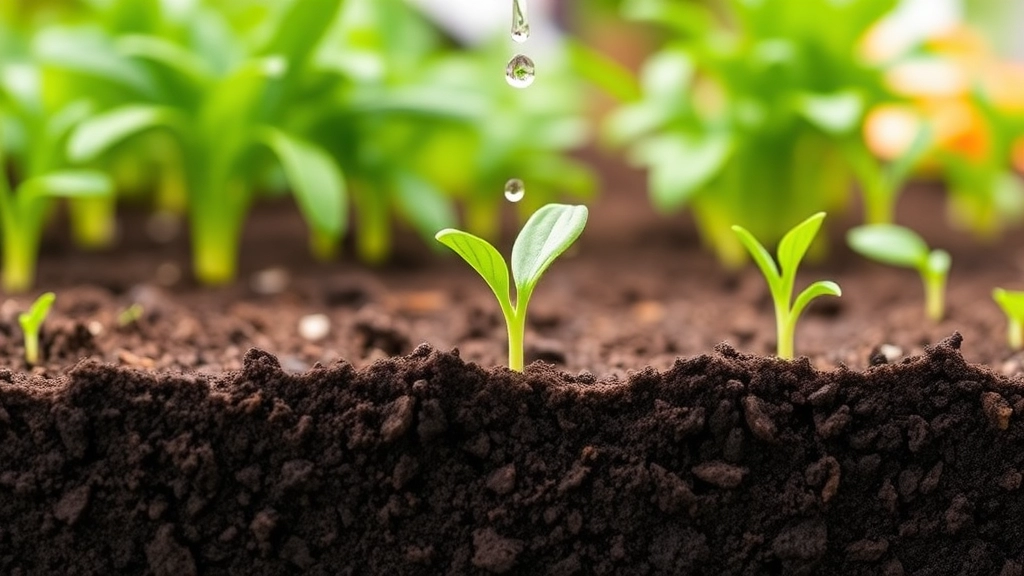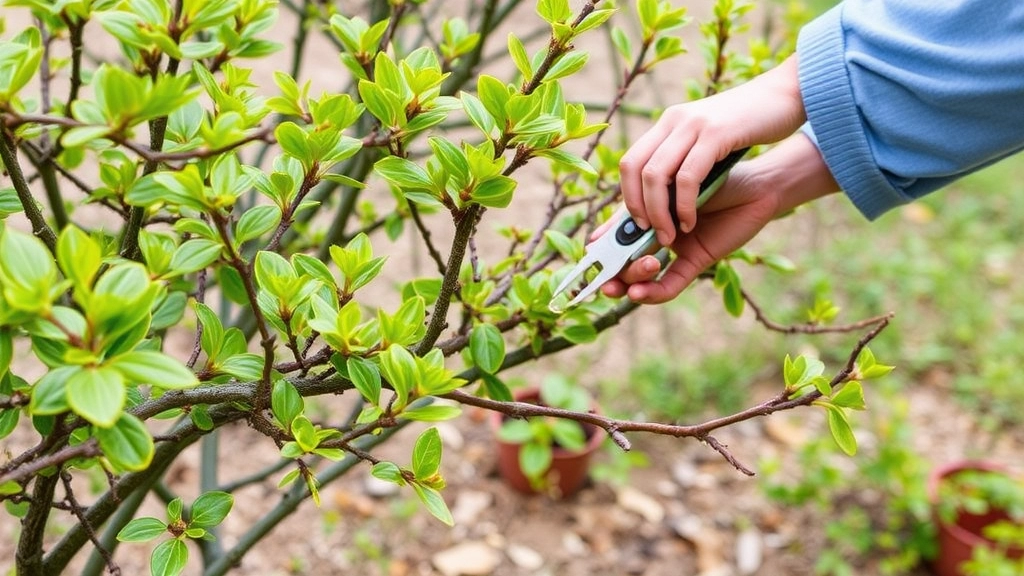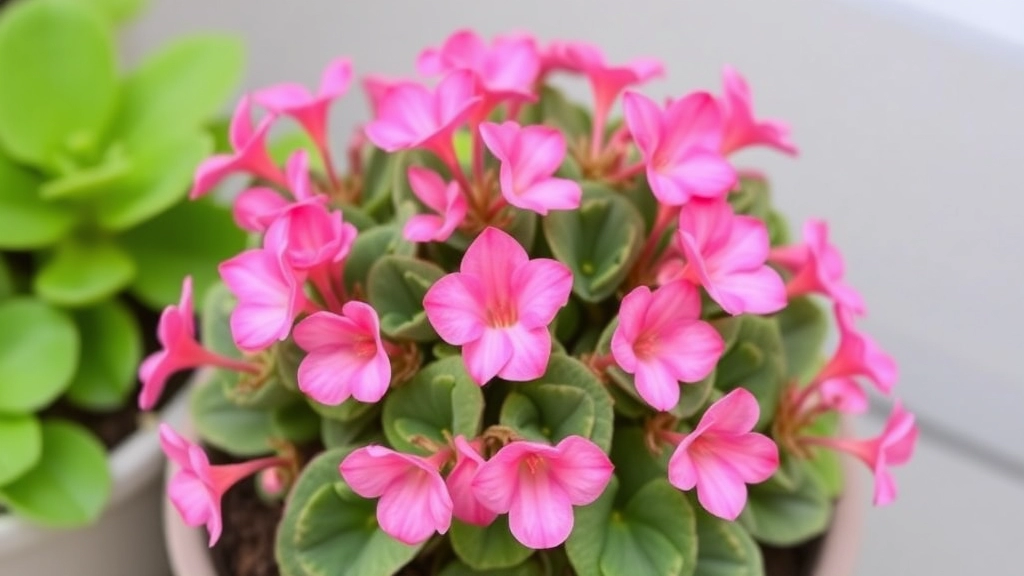Pink Kalanchoe Plant Care
If you’re looking to keep your Pink Kalanchoe plant thriving, you’ve come to the right place. Pink Kalanchoe plant care is straightforward if you know what to focus on. From ideal light and temperature conditions to proper watering and soil requirements, I’ll guide you through everything you need to ensure your plant stays vibrant and healthy.
Essentials of Care
Understanding the essentials of fertilization, pruning, and pest management is key to maintaining those stunning pink blooms. Whether you’re growing your Kalanchoe indoors or outdoors, these tips will help you troubleshoot common issues and keep your plant looking its best year-round.
Ideal Light and Temperature Conditions
Are you struggling to keep your plants thriving? One of the most common issues is inadequate light and temperature conditions.
Understanding the ideal environment for your plants can make all the difference in their growth and vibrancy.
Light Requirements
Plants generally thrive in bright, indirect sunlight. Here are some key points to consider:
- Direct Sunlight: Some plants, like succulents, love direct sunlight. Place them in south-facing windows.
- Indirect Light: Most houseplants prefer bright, indirect light. East or west-facing windows are often ideal.
- Low Light: If your space has minimal natural light, consider low-light plants such as snake plants or pothos.
Temperature Preferences
Temperature also plays a crucial role in plant health. Here’s what to keep in mind:
- Ideal Range: Most houseplants prefer temperatures between 18°C to 24°C (65°F to 75°F).
- Nighttime Temperatures: A slight drop at night can benefit plants, ideally around 15°C to 18°C (59°F to 65°F).
- Avoid Extremes: Keep plants away from draughts, heaters, and air conditioning vents, as sudden temperature changes can stress them.
For more specific care tips, check out our guide on fixing etiolated Kalanchoe Blossfeldiana and learn how to optimize light conditions for your succulents.
Additionally, understanding the indoor vs outdoor care guide for Kalanchoe Blossfeldiana can help you provide the best environment for your plants.
Watering and Soil Requirements

Have you ever wondered why your plants seem to droop despite your best efforts?
Watering and soil conditions play a vital role in keeping your plants happy and thriving.
Watering Tips
- Consistency is Key: Aim for a regular watering schedule.
- Check the Soil: Stick your finger in the soil; if it feels dry an inch down, it’s time to water.
- Water Deeply: When you do water, give them a good soak. This encourages roots to grow deeper.
- Avoid Overwatering: Too much water can lead to root rot. Always ensure pots have drainage holes.
Soil Requirements
- Well-draining Soil: Use a mix that allows excess water to escape while retaining some moisture.
- Organic Matter: Incorporate compost or peat moss for nutrients and better structure.
- pH Level: Most plants prefer slightly acidic to neutral soil (pH 6.0-7.0).
Fertilization Tips for Vibrant Blooms
As we delve deeper into nurturing your plants, it’s essential to discuss how fertilization plays a pivotal role in achieving those vibrant blooms you desire. Many plant enthusiasts often wonder how to strike the right balance with fertilisers to promote healthy growth without overwhelming their plants.
Choosing the Right Fertiliser
- Type of Fertiliser:
- Opt for a balanced fertiliser, such as a 10-10-10 NPK formula. This ensures your plants receive equal parts nitrogen, phosphorus, and potassium.
- Consider organic options like compost or well-rotted manure for a more natural approach.
- Frequency of Application:
- During the growing season (spring and summer), fertilise every 4-6 weeks.
- In autumn and winter, reduce feeding as most plants enter a dormant phase.
Application Techniques
- Dilution: Always dilute liquid fertilisers according to the package instructions. Over-fertilising can burn roots and hinder growth.
- Even Distribution: Apply fertiliser evenly around the base of the plant, avoiding direct contact with the stems or leaves.
Signs of Nutrient Deficiency
- Yellowing leaves? This might indicate a nitrogen deficiency.
- Poor flowering? It could be a lack of phosphorus.
Real-Life Example
I remember when I first started gardening, my flowers were lacklustre. After some research, I switched to a balanced fertiliser and saw a remarkable transformation. The blooms were not only vibrant but also more abundant.
If you are looking to enhance the vibrancy of your Kalanchoe plants, you might find our guide on vibrant Kalanchoe Blossfeldiana colors very helpful. Additionally, for those interested in organic options, our Kalanchoe Panda Plant care tips include great insights on using natural fertilizers.
Pruning and Shaping Techniques

When it comes to maintaining the health and beauty of your plants, pruning and shaping are vital practices. You might be wondering: How often should I prune? What are the best techniques to shape my plants? Let’s dive into these essential tips.
Why Pruning Matters
Pruning not only encourages new growth but also helps in shaping your plants for a more aesthetically pleasing appearance. Proper pruning can:
- Enhance Airflow: Reducing overcrowded branches allows for better air circulation, which can prevent diseases.
- Promote Flowering: Many plants bloom better when pruned at the right time.
- Control Size: Keeping plants at a manageable size makes them easier to care for.
Essential Pruning Techniques
- Timing is Key:
- Prune during the dormant season for most plants, typically late winter or early spring.
- For flowering plants, prune right after they bloom to avoid cutting off next season’s buds.
- Use the Right Tools:
- Sharp, clean pruning shears are essential for making clean cuts.
- Consider using loppers for thicker branches.
- Cutting Techniques:
- Angle Your Cuts: Always cut at a 45-degree angle to promote healing.
- Remove Dead or Diseased Wood: This keeps your plant healthy and encourages new growth.
- Shaping Your Plants:
- Pinching: For bushy plants, pinch back the tips of branches to encourage branching.
- Thinning: Remove some branches entirely to open up the centre of the plant.
Common Mistakes to Avoid
- Over-Pruning: Cutting too much can stress the plant. Always err on the side of caution.
- Ignoring Plant Type: Different plants have different needs. Research specific requirements for your varieties.
By integrating these pruning and shaping techniques, your plants will flourish and maintain their beauty throughout the seasons.
Managing Pests and Common Diseases
As we delve into the care of your plants, it’s essential to address a concern that many gardeners face: pests and diseases. These issues can quickly derail your efforts, but with the right strategies, you can safeguard your blooms.
VI. Seasonal Care and Repotting Recommendations
Ever wondered how to keep your plants thriving through the changing seasons?
Let’s dive into some straightforward seasonal care tips and when to repot your green friends.
Seasonal Care Tips
- Spring Awakening
– As the days grow longer, your plants will start to wake up.
– Increase watering and start fertilising to boost growth.
– Check for new growth and adjust light exposure if needed. - Summer Sunshine
– Keep an eye on moisture levels; hot weather can dry out soil quickly.
– Consider moving plants to a shadier spot if they’re getting scorched.
– Regularly check for pests, as they love the warm weather. - Autumn Transition
– Gradually reduce watering as plants enter dormancy.
– Stop fertilising, giving your plants a chance to rest.
– Inspect for any signs of disease before winter hits. - Winter Care
– Most plants need less water; overwatering can lead to root rot.
– Keep them in a well-lit area, but avoid direct drafts from windows.
– Dust leaves gently to help them breathe.
Repotting Recommendations
Repotting can be a bit daunting, but it’s essential for healthy growth. Here’s when and how to do it:
- When to Repot
– If roots are poking out of the drainage holes.
– When the plant isn’t growing as vigorously as before.
– Ideally, repot in spring when plants are actively growing. - How to Repot
– Choose a pot that’s 1-2 inches larger in diameter.
– Use fresh potting mix to provide nutrients.
– Gently loosen the root ball and remove any dead roots.
FAQs on Pink Kalanchoe Plant Care
How often should I water my Pink Kalanchoe?
Consistency is key when it comes to watering. Aim for a regular watering schedule and check the soil. If it feels dry an inch down, it’s time to water.
What type of soil is best for Pink Kalanchoe?
Pink Kalanchoe thrives in well-draining soil. Incorporate compost or peat moss for nutrients and ensure the soil has a slightly acidic to neutral pH level (6.0-7.0).
How can I prevent overwatering my Pink Kalanchoe?
To avoid overwatering, always ensure that your pots have drainage holes. Water deeply but infrequently, allowing the soil to dry out between waterings to prevent root rot.
When is the best time to prune my Pink Kalanchoe?
Prune during the dormant season, typically late winter or early spring. For flowering plants, prune right after they bloom to avoid cutting off next season’s buds.
What tools should I use for pruning my Pink Kalanchoe?
Use sharp, clean pruning shears for making clean cuts. For thicker branches, consider using loppers.
What are some essential pruning techniques for Pink Kalanchoe?
Always cut at a 45-degree angle to promote healing. Remove dead or diseased wood to keep your plant healthy and encourage new growth. For shaping, pinch back the tips of branches to encourage branching and thin out some branches to open up the center of the plant.
What are common mistakes to avoid when caring for Pink Kalanchoe?
Avoid over-pruning as it can stress the plant. Always research specific requirements for your plant variety to ensure you are meeting its unique needs.
References
-
Pruning Houseplants: Tips For Pruning Indoor Plants
-
Plant Watering Tips
-
Plant Soil Requirements
